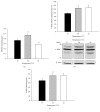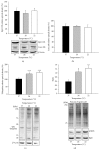Subnormothermic Perfusion in the Isolated Rat Liver Preserves the Antioxidant Glutathione and Enhances the Function of the Ubiquitin Proteasome System
- PMID: 27800122
- PMCID: PMC5075307
- DOI: 10.1155/2016/9324692
Subnormothermic Perfusion in the Isolated Rat Liver Preserves the Antioxidant Glutathione and Enhances the Function of the Ubiquitin Proteasome System
Abstract
The reduction of oxidative stress is suggested to be one of the main mechanisms to explain the benefits of subnormothermic perfusion against ischemic liver damage. In this study we investigated the early cellular mechanisms induced in isolated rat livers after 15 min perfusion at temperatures ranging from normothermia (37°C) to subnormothermia (26°C and 22°C). Subnormothermic perfusion was found to maintain hepatic viability. Perfusion at 22°C raised reduced glutathione levels and the activity of glutathione reductase; however, lipid and protein oxidation still occurred as determined by malondialdehyde, 4-hydroxynonenal-protein adducts, and advanced oxidation protein products. In livers perfused at 22°C the lysosomal and ubiquitin proteasome system (UPS) were both activated. The 26S chymotrypsin-like (β5) proteasome activity was significantly increased in the 26°C (46%) and 22°C (42%) groups. The increased proteasome activity may be due to increased Rpt6 Ser120 phosphorylation, which is known to enhance 26S proteasome activity. Together, our results indicate that the early events produced by subnormothermic perfusion in the liver can induce oxidative stress concomitantly with antioxidant glutathione preservation and enhanced function of the lysosomal and UPS systems. Thus, a brief hypothermia could trigger antioxidant mechanisms and may be functioning as a preconditioning stimulus.
Figures






Similar articles
-
Hypothermia can reverse hepatic oxidative stress damage induced by hypoxia in rats.J Physiol Biochem. 2016 Dec;72(4):615-623. doi: 10.1007/s13105-016-0500-x. Epub 2016 Jul 8. J Physiol Biochem. 2016. PMID: 27387890
-
Proteasome and antioxidant responses in Cottus gobio during a combined exposure to heat stress and cadmium.Comp Biochem Physiol C Toxicol Pharmacol. 2012 Mar;155(2):318-24. doi: 10.1016/j.cbpc.2011.10.003. Epub 2011 Oct 19. Comp Biochem Physiol C Toxicol Pharmacol. 2012. PMID: 22033351
-
Chronic ethanol consumption results in atypical liver injury in copper/zinc superoxide dismutase deficient mice.Alcohol Clin Exp Res. 2010 Feb;34(2):251-61. doi: 10.1111/j.1530-0277.2009.01088.x. Epub 2009 Nov 30. Alcohol Clin Exp Res. 2010. PMID: 19951287
-
Protein damage, repair and proteolysis.Mol Aspects Med. 2014 Feb;35:1-71. doi: 10.1016/j.mam.2012.09.001. Epub 2012 Oct 26. Mol Aspects Med. 2014. PMID: 23107776 Review.
-
Redox control of the ubiquitin-proteasome system: from molecular mechanisms to functional significance.Antioxid Redox Signal. 2011 Oct 15;15(8):2265-99. doi: 10.1089/ars.2010.3590. Epub 2011 May 25. Antioxid Redox Signal. 2011. PMID: 21314436 Review.
Cited by
-
Ubiquitin-proteasome system and oxidative stress in liver transplantation.World J Gastroenterol. 2018 Aug 21;24(31):3521-3530. doi: 10.3748/wjg.v24.i31.3521. World J Gastroenterol. 2018. PMID: 30131658 Free PMC article. Review.
-
Preconditioning-Like Properties of Short-Term Hypothermia in Isolated Perfused Rat Liver (IPRL) System.Int J Mol Sci. 2018 Mar 29;19(4):1023. doi: 10.3390/ijms19041023. Int J Mol Sci. 2018. PMID: 29596325 Free PMC article.
References
-
- Nagano K., Gelman S., Bradley E. L., Jr., Parks D. Hypothermia, hepatic oxygen supply-demand, and ischemia-reperfusion injury in pigs. American Journal of Physiology—Gastrointestinal and Liver Physiology. 1990;258(6):G910–G918. - PubMed
-
- Kuboki S., Okaya T., Schuster R., et al. Hepatocyte NF-κB activation is hepatoprotective during ischemia-reperfusion injury and is augmented by ischemic hypothermia. American Journal of Physiology—Gastrointestinal and Liver Physiology. 2007;292(1):G201–G207. doi: 10.1152/ajpgi.00186.2006. - DOI - PubMed
MeSH terms
Substances
LinkOut - more resources
Full Text Sources
Other Literature Sources
Medical
Molecular Biology Databases

